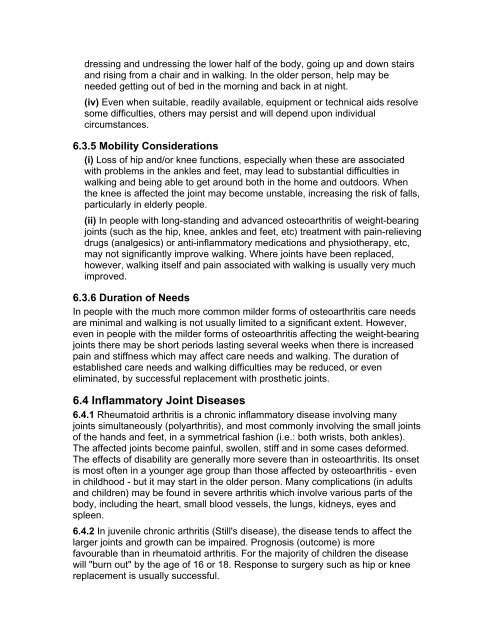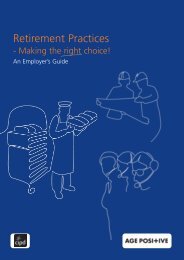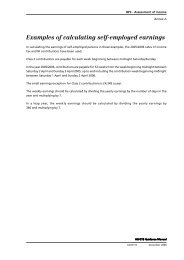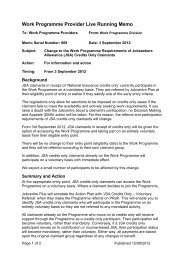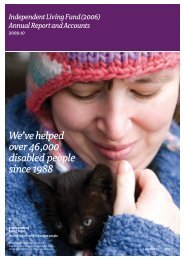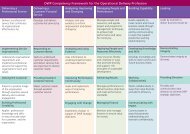Arthritis, rheumatism, musculo-skeletal and rheumatological disorders
Arthritis, rheumatism, musculo-skeletal and rheumatological disorders
Arthritis, rheumatism, musculo-skeletal and rheumatological disorders
You also want an ePaper? Increase the reach of your titles
YUMPU automatically turns print PDFs into web optimized ePapers that Google loves.
dressing <strong>and</strong> undressing the lower half of the body, going up <strong>and</strong> down stairs<br />
<strong>and</strong> rising from a chair <strong>and</strong> in walking. In the older person, help may be<br />
needed getting out of bed in the morning <strong>and</strong> back in at night.<br />
(iv) Even when suitable, readily available, equipment or technical aids resolve<br />
some difficulties, others may persist <strong>and</strong> will depend upon individual<br />
circumstances.<br />
6.3.5 Mobility Considerations<br />
(i) Loss of hip <strong>and</strong>/or knee functions, especially when these are associated<br />
with problems in the ankles <strong>and</strong> feet, may lead to substantial difficulties in<br />
walking <strong>and</strong> being able to get around both in the home <strong>and</strong> outdoors. When<br />
the knee is affected the joint may become unstable, increasing the risk of falls,<br />
particularly in elderly people.<br />
(ii) In people with long-st<strong>and</strong>ing <strong>and</strong> advanced osteoarthritis of weight-bearing<br />
joints (such as the hip, knee, ankles <strong>and</strong> feet, etc) treatment with pain-relieving<br />
drugs (analgesics) or anti-inflammatory medications <strong>and</strong> physiotherapy, etc,<br />
may not significantly improve walking. Where joints have been replaced,<br />
however, walking itself <strong>and</strong> pain associated with walking is usually very much<br />
improved.<br />
6.3.6 Duration of Needs<br />
In people with the much more common milder forms of osteoarthritis care needs<br />
are minimal <strong>and</strong> walking is not usually limited to a significant extent. However,<br />
even in people with the milder forms of osteoarthritis affecting the weight-bearing<br />
joints there may be short periods lasting several weeks when there is increased<br />
pain <strong>and</strong> stiffness which may affect care needs <strong>and</strong> walking. The duration of<br />
established care needs <strong>and</strong> walking difficulties may be reduced, or even<br />
eliminated, by successful replacement with prosthetic joints.<br />
6.4 Inflammatory Joint Diseases<br />
6.4.1 Rheumatoid arthritis is a chronic inflammatory disease involving many<br />
joints simultaneously (polyarthritis), <strong>and</strong> most commonly involving the small joints<br />
of the h<strong>and</strong>s <strong>and</strong> feet, in a symmetrical fashion (i.e.: both wrists, both ankles).<br />
The affected joints become painful, swollen, stiff <strong>and</strong> in some cases deformed.<br />
The effects of disability are generally more severe than in osteoarthritis. Its onset<br />
is most often in a younger age group than those affected by osteoarthritis - even<br />
in childhood - but it may start in the older person. Many complications (in adults<br />
<strong>and</strong> children) may be found in severe arthritis which involve various parts of the<br />
body, including the heart, small blood vessels, the lungs, kidneys, eyes <strong>and</strong><br />
spleen.<br />
6.4.2 In juvenile chronic arthritis (Still's disease), the disease tends to affect the<br />
larger joints <strong>and</strong> growth can be impaired. Prognosis (outcome) is more<br />
favourable than in rheumatoid arthritis. For the majority of children the disease<br />
will "burn out" by the age of 16 or 18. Response to surgery such as hip or knee<br />
replacement is usually successful.


